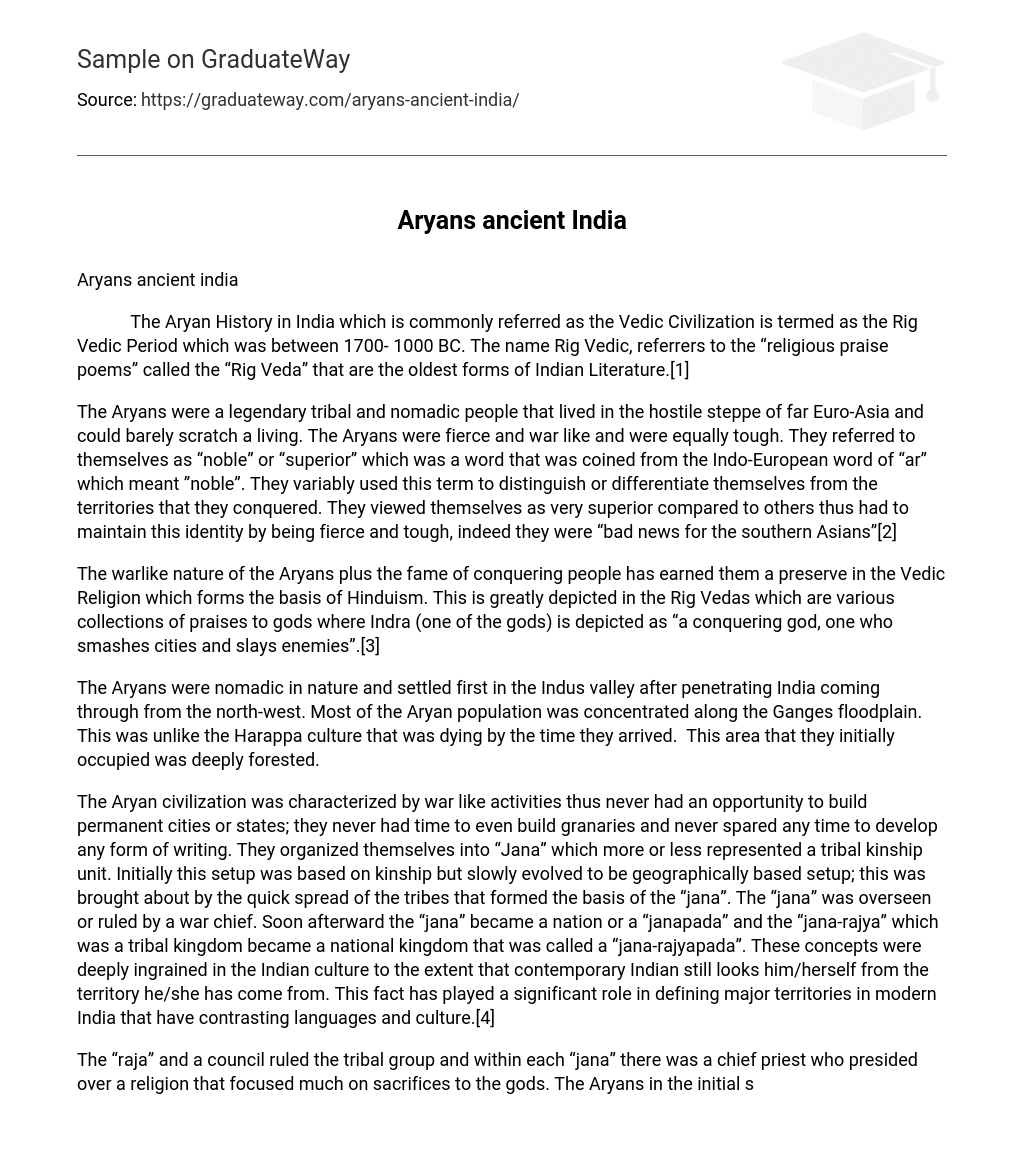The Aryan History in India which is commonly referred as the Vedic Civilization is termed as the Rig Vedic Period which was between 1700- 1000 BC. The name Rig Vedic, referrers to the “religious praise poems” called the “Rig Veda” that are the oldest forms of Indian Literature.[1]
The Aryans were a legendary tribal and nomadic people that lived in the hostile steppe of far Euro-Asia and could barely scratch a living. The Aryans were fierce and war like and were equally tough. They referred to themselves as “noble” or “superior” which was a word that was coined from the Indo-European word of “ar” which meant ”noble”. They variably used this term to distinguish or differentiate themselves from the territories that they conquered. They viewed themselves as very superior compared to others thus had to maintain this identity by being fierce and tough, indeed they were “bad news for the southern Asians”[2]
The warlike nature of the Aryans plus the fame of conquering people has earned them a preserve in the Vedic Religion which forms the basis of Hinduism. This is greatly depicted in the Rig Vedas which are various collections of praises to gods where Indra (one of the gods) is depicted as “a conquering god, one who smashes cities and slays enemies”.[3]
The Aryans were nomadic in nature and settled first in the Indus valley after penetrating India coming through from the north-west. Most of the Aryan population was concentrated along the Ganges floodplain. This was unlike the Harappa culture that was dying by the time they arrived. This area that they initially occupied was deeply forested.
The Aryan civilization was characterized by war like activities thus never had an opportunity to build permanent cities or states; they never had time to even build granaries and never spared any time to develop any form of writing. They organized themselves into “Jana” which more or less represented a tribal kinship unit. Initially this setup was based on kinship but slowly evolved to be geographically based setup; this was brought about by the quick spread of the tribes that formed the basis of the “jana”. The “jana” was overseen or ruled by a war chief. Soon afterward the “jana” became a nation or a “janapada” and the “jana-rajya” which was a tribal kingdom became a national kingdom that was called a “jana-rajyapada”. These concepts were deeply ingrained in the Indian culture to the extent that contemporary Indian still looks him/herself from the territory he/she has come from. This fact has played a significant role in defining major territories in modern India that have contrasting languages and culture.[4]
The “raja” and a council ruled the tribal group and within each “jana” there was a chief priest who presided over a religion that focused much on sacrifices to the gods. The Aryans in the initial setup classified themselves into two distinct social classes, the “commoners” and the “nobles”. However, eventually they added a third class which was called the “dasas” or the “darks”. This name emanated, it is presumed from the dark skinned inhabitants of the territories they had conquered.[5]
It is important to note that by the end of the Rig Vedic period, there were four distinct social classes or castes or the “caturvarnas”. At the top of this social class were the priests or the “Brahamans”, the next slot was occupied by the “Kashatriya” who were the warriors or the nobles. The third slot was taken up by the “Vishya” comprising of the craftspeople and the merchants. At the bottom of this classification were the “Shudra” who comprised the largest group within the society. This class system was legalized by the “elaborate religious system” which would later form the basis of the “caste” system as we know it today in India.[6]
The Aryan civilization played a significant role in the Indian culture and religion as we know it today. Although the Indian culture has evolved close to over 7,000 years ago, it is the Rig Vedic civilization that that played the major role in shaping modern India.
Map picked from: http://www.sfusd.k12.ca.us/schwww/sch618/India/History.html
Works Cited
http://www.wsu.edu/~dee/ANCINDIA/ARYANS.HTM: Accessed on 19th January 2007
[1] http://www.wsu.edu/~dee/ANCINDIA/ARYANS.HTM
[2] http://www.wsu.edu/~dee/ANCINDIA/ARYANS.HTM
[3] http://www.wsu.edu/~dee/ANCINDIA/ARYANS.HTM
[4] http://www.wsu.edu/~dee/ANCINDIA/ARYANS.HTM
[5] http://www.wsu.edu/~dee/ANCINDIA/ARYANS.HTM
[6] http://www.wsu.edu/~dee/ANCINDIA/ARYANS.HTM





